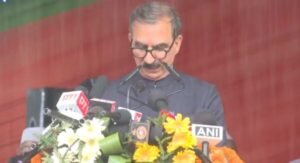
Punjab Singh Tapwal, an advocate by profession, had long nurtured a desire to contribute meaningfully to the development of his village.
Mandi (Himachal Pradesh), 29 November, Friday
Kumud Sharma, Diary Times: In the tranquil hills of Himachal Pradesh, an unexpected transformation is taking place. What were once barren, unproductive plots of land are now buzzing hubs of sustainable energy production, thanks to a forward-thinking solar energy policy that is lighting up rural economies. In particular, the story of Punjab Singh Tapwal from the village of Jandharu Khurd is a shining example of how solar power is not just transforming landscapes, but also livelihoods.
The Rise of Solar Power: A Vision for Rural Prosperity
Punjab Singh Tapwal, an advocate by profession, had long nurtured a desire to contribute meaningfully to the development of his village. With eight bighas of barren land that was unsuitable for farming and plagued by wild animals, Tapwal found an unlikely solution: solar power. Under the Himachal Pradesh government’s newly streamlined solar policy, he seized the opportunity to turn his land into a solar energy farm.
In July 2024, his 500-kilowatt solar plant was commissioned, with a hefty investment of ₹1.70 crore, aided by a loan from the Central Bank of India and support from Him Urja, the state’s energy department. Today, his solar plant generates ₹2–3 lakh in monthly income, demonstrating how harnessing the sun’s energy can turn challenges into golden opportunities.
The Power of Government Support: A Game-Changer for Entrepreneurs
Himachal Pradesh’s solar policy has introduced a much-needed lifeline for entrepreneurs like Tapwal, who, despite facing challenges in the past, found success through the state’s new streamlined application system. The solar plant, which sells electricity at ₹3.75 per unit, is not just a profitable venture but a step toward environmental sustainability, positioning Himachal Pradesh as a green energy leader in India.
Tapwal’s success story is a reflection of the larger vision set forth by Chief Minister Sukhvinder Singh Sukhu’s government. By simplifying the process of setting up solar plants and offering subsidies, the government has enabled many individuals, including farmers and local advocates, to become energy producers.
A New Dawn for Mandi District: Solar Power as a Catalyst for Change
Mandi district, where Tapwal’s solar plant is located, is quickly becoming a hotbed for renewable energy projects. In total, the district has 16 solar plants, collectively generating 6.86 MW of electricity. Deputy Commissioner Apoorv Devgan is spearheading efforts to expand solar energy use throughout the district, focusing on optimizing barren lands and creating job opportunities for locals.
Superintending Engineer Arun Sharma adds that other villages in Mandi, such as Sadhwani, Bari-Gumanu, and Bhadrwar, are also seeing a rise in solar installations. These projects are transforming previously unproductive land into valuable energy assets, thus creating a ripple effect of employment and economic growth in rural communities.
Renewable Energy: A Pillar of Sustainable Growth and Environmental Conservation
The shift to solar energy goes beyond economic benefits. It aligns with Himachal Pradesh’s broader commitment to environmental conservation. By reducing dependency on non-renewable energy sources, the state is contributing to national and global sustainability efforts. The solar energy projects in Mandi are helping to mitigate carbon emissions and reduce the state’s reliance on fossil fuels, making it a model for other regions.
For Tapwal, the solar plant represents not only a business venture but a long-term commitment to environmental stewardship. He expects to break even within 8 to 10 years, with steady profits for the next 15 years. The combination of economic prosperity and environmental preservation reflects the success of Himachal’s green energy strategy.
The Future is Bright: Harnessing Solar Power for Self-Reliance
Punjab Singh Tapwal’s journey is just one of many emerging stories across Himachal Pradesh. The state’s commitment to green energy is creating pathways for individuals to achieve self-reliance, contribute to sustainable development, and promote environmental harmony. For many, the sun is no longer just a source of light but a beacon of hope for a brighter, greener future.
Tapwal’s success has already inspired others in the region to explore solar projects, contributing to the growth of a green economy. As more people turn to solar energy, Himachal Pradesh is set to become a shining example of how renewable energy can empower individuals, transform landscapes, and propel a region towards a sustainable future.

Continuing the achievement of the journey of effectiveness and credibility of more than 10 years in the career of journalism, as a woman journalist, I am Serving as the founder, promoter and editor of DiaryTimes with the trust and support of all. My credible coverage may not have given a big shape to the numbers, but my journey presents articles that make you aware of the exact and meaningful situations of Himachal’s politics, ground issues related to the public, business, tourism and the difficult geographical conditions of the state and financial awareness. DiaryTimes, full of the experience of my precise editorial expertise, is awakening the flame of credible journalism among all of you, so that the eternal flame of meaningful change can be lit in the life of the people of the state and the atrocities being committed against the people can be brought to the fore, I am motivated for that. If even a small change comes with the power of my journalism and the whole world becomes a witness to that issues, then I will consider myself fortunate.








